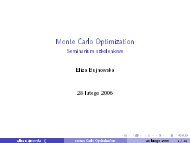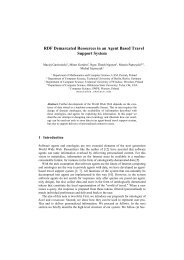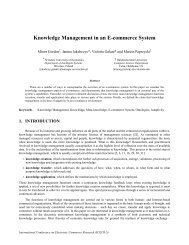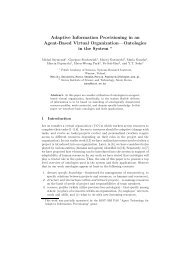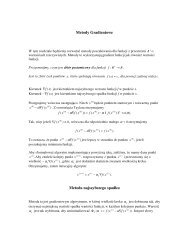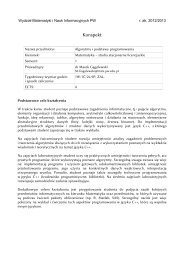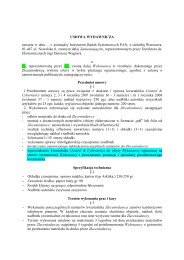An Extended Fuzzy Boolean Model of Information Retrieval Revisited
An Extended Fuzzy Boolean Model of Information Retrieval Revisited
An Extended Fuzzy Boolean Model of Information Retrieval Revisited
Create successful ePaper yourself
Turn your PDF publications into a flip-book with our unique Google optimized e-Paper software.
<strong>An</strong> <strong>Extended</strong> <strong>Fuzzy</strong> <strong>Boolean</strong> <strong>Model</strong> <strong>of</strong> <strong>Information</strong><strong>Retrieval</strong> <strong>Revisited</strong>Sławomir ZadrożnySystems Research InstitutePolish Academy <strong>of</strong> Sciencesul. Newelska 6, 01–447 Warsaw, Polandzadrozny@ibspan.waw.plJanusz KacprzykSystems Research InstitutePolish Academy <strong>of</strong> Sciencesul. Newelska 6, 01–447 Warsaw, Polandkacprzyk@ibspan.waw.plAbstract— <strong>An</strong> extension to the classical <strong>Boolean</strong> model <strong>of</strong>information retrieval is discussed. The approach is based onrecent advances in the area <strong>of</strong> fuzzy logic in a narrow sense. Astrictly formal logical interpretation is provided for all elements<strong>of</strong> the model including the representation <strong>of</strong> both documents andqueries and the evaluation <strong>of</strong> queries.I. INTRODUCTIONResearch on information retrieval has a long history. Traditionallythree models <strong>of</strong> retrieval are assumed in the literature:<strong>Boolean</strong>, vector space and probabilistic. Many variations andextensions to these models have been proposed. In practice thefirst one seems to be the most widely employed in commercialinformation retrieval systems. In its classical form it <strong>of</strong>fersa strong querying language based logical concepts and atthe same time a rather inflexible document representation.The vector space model appears to be complementary in thisrespect. Hence, the combination <strong>of</strong> them should be beneficial.The re-interpretation <strong>of</strong> the <strong>Boolean</strong> model should provide asound theoretical background for such a combination.The idea <strong>of</strong> the fuzzy logic based information retrievalsystem has been studied and developed by many authors, cf.,e.g., [1], [2], [3], [4], [5], [6], [7], [8], [9]. However, newadvancements in the area <strong>of</strong> fuzzy logic in a narrow senseexemplified by the work <strong>of</strong> Hajek [10] or Novak and Perfilieva[11], [12], [13] open new possibilities for a consistent logicaltreatment <strong>of</strong> all the elements <strong>of</strong> the information retrievalmodel.Basically, a model <strong>of</strong> information retrieval should addressat least three aspects:• representation <strong>of</strong> documents• representation <strong>of</strong> queries• methods used to evaluate the matching <strong>of</strong> a query againsta document.In this paper 1 we look for the interpretation <strong>of</strong> all thisaspects in terms <strong>of</strong> fuzzy propositional logic. We combineconcepts and solutions proposed previously in the literaturewith some original contributions. Our goal is to provide for aunified interpretation <strong>of</strong> the retrieval process in terms <strong>of</strong> fuzzylogic rather than to <strong>of</strong>fer specific solutions regarding particularaspects <strong>of</strong> this process, e.g., new weighting scheme.1 Research supported by the KBN Grant 3 T11C 052 27The paper is composed as follows. Section II presents theclassical <strong>Boolean</strong> model <strong>of</strong> information retrieval. We try t<strong>of</strong>ormalize all elements <strong>of</strong> the model in the spirit <strong>of</strong> the classicalpropositional calculus. We also briefly discuss some otherlogical approaches that may be relevant for our purposes. InSection III fuzzy propositional logics are discussed, mainlyfrom the perspective <strong>of</strong> [12], [13], [10]. The first reference isin a sense (for our purposes) a “naive” one, directly emergingfrom fuzzy sets theory. We are less rigorous in its presentation.The second reference is a more sophisticated logic whichprovides a theoretical background for a more comprehensiveextension <strong>of</strong> the classical <strong>Boolean</strong> model. Finally, in SectionIV we demonstrate how elements <strong>of</strong> extended <strong>Boolean</strong> modelmay be expressed in terms <strong>of</strong> fuzzy propositional logic discussedin the previous section.II. THE CLASSICAL BOOLEAN MODEL OF INFORMATIONRETRIEVALWe will briefly characterize the classical <strong>Boolean</strong> model interms <strong>of</strong> the document and query representation, as well as<strong>of</strong> the query evaluation. This will be a starting point for theextension <strong>of</strong> the model towards its fuzzy counterpart. In thepaper we assume the following notation:D = {d i } i=1,N − a set <strong>of</strong> text documentsT = {t j } j=1,M − a set <strong>of</strong> index termsIn what follows we will denote by d both a document andits representation and the proper interpretation <strong>of</strong> d should beclear from the context. In the <strong>Boolean</strong> model a document isrepresented by a set <strong>of</strong> index terms assigned to it. It may bespecified formally in several ways. In a most straightforwardway, a document may be identified with a set <strong>of</strong> index terms,i.e.,:d i = {t k } k=1,Kd i ∈ D, t k ∈ TSecond, such a set may be equivalently specified by itscharacteristic function or, more practically, by a binary vectorwith coordinates corresponding to the particular index terms.This representation may be further generalized, towards the
formalism typical for the vector space model, introducing afunction F such that:F : D × T −→ {0, 1} (1)Still another propositional logic based formalisation <strong>of</strong> the<strong>Boolean</strong> representation <strong>of</strong> documents is possible, and it is moreappropriate for the logical character <strong>of</strong> the model. Namely, weassociate with each index term t j a propositional variable s j .Then, a document is represented by a propositional formulabeing a conjunction <strong>of</strong> propositional variables correspondingto the index terms assigned to this document, and the negations<strong>of</strong> propositional variables corresponding to the rest <strong>of</strong> indexterms. For example, let a set <strong>of</strong> index terms consist <strong>of</strong>“computer”, “internet”, “network”, “journal” and “magazine”.Then, a document d to which the first three <strong>of</strong> them areassigned is be represented as:s 1 ∧ s 2 ∧ s 3 ∧ ¬s 4 ∧ ¬s 5 (2)assuming that the propositional variables s 1 , . . . s 5 are associatedwith the subsequent index terms. Such an approachopens new vistas for a more sophisticated representations <strong>of</strong>documents in which not just a conjunction <strong>of</strong> index terms,but more complex formulae are also applicable. This is in thespirit <strong>of</strong> the logical approach to the modelling <strong>of</strong> informationretrieval initiated by van Rijsbergen [14], [15]. We will dwellon it just after discussing the evaluation mechanism <strong>of</strong> the<strong>Boolean</strong> model. Moreover, we will then <strong>of</strong>fer still another viewon the representation <strong>of</strong> a document in the framework <strong>of</strong> the<strong>Boolean</strong> model.In the classical <strong>Boolean</strong> model the query is a formula in thesense <strong>of</strong> propositional logic. Again, the propositional variablesin such a formula represent the particular index terms, and maybe combined using the logical connectives, notably the negation,conjunction and disjunction. For example, a query: “Finddocuments on computer or network” is represented, assumingthe same correspondence between propositional variables andindex terms as in (2), as:s 1 ∨ s 3 (3)Finally, the third element <strong>of</strong> the <strong>Boolean</strong> model, i.e., thequery evaluation mechanism refers to the truth or validity <strong>of</strong>the formula representing the query. Informally, for a givendocument d, a propositional variable s j <strong>of</strong> a query q is assigneda truth value “true” if the corresponding index term appearsin the representation <strong>of</strong> the document d, and is assigned thevalue “false” otherwise. Then, the truth degree for the wholeformula/query is computed as usually in the framework <strong>of</strong> thepropositional logic semantics, i.e., exploiting truth functionality<strong>of</strong> the logical connectives. The document is deemed tobe relevant to the query if and only if the formula evaluationyields “true”.More formally, in the spirit <strong>of</strong> van Rijsbergen’s [14], [15]approach, the issue <strong>of</strong> matching query q against document dis considered as related to the truth <strong>of</strong> (or the probability <strong>of</strong>the truth <strong>of</strong>) formula d ⇒ q. Sebastiani [16] discussed severalpossible, and studied in the literature, interpretations <strong>of</strong> d ⇒ qas an indicator <strong>of</strong> the relevance <strong>of</strong> document d for query q.Namely, [16], in order to declare the matching one may requirethat:1) d ⇒ q is true under some particular valuation <strong>of</strong>propositional variables s j ,2) q is semantically implied by d (d |= q),3) d ⇒ q is a tautology (|= d ⇒ q),4) q is provable from d (d ⊢ q),5) d ⇒ q is a theorem (⊢ d ⇒ q)(4)In the specific context <strong>of</strong> the classical propositional logic,the interpretations 2) – 5) coincide, while the interpretation 1)does not seem to make much sense.For our purposes, we assume an equivalent for <strong>of</strong> the interpretations2) —5) but apparently more natural understanding<strong>of</strong> the relevance based on a slightly different representation<strong>of</strong> documents. Namely, a document might be understood notas a formula <strong>of</strong> propositional logic, but as a valuation inthe sense <strong>of</strong> semantics <strong>of</strong> this logic (i.e., as an assignment<strong>of</strong> truth values to propositional variables). More specifically,such a valuation υ d (subindex d will be used to indicate thatthis valuation is implied by document d) directly corresponds,informally speaking, to the above mechanism for the <strong>Boolean</strong>query evaluation, i.e.:{ true if tj ∈ dυ d (s j ) =(5)false otherwiseThen, query q matches document d if it is true undervaluation υ d .The classical <strong>Boolean</strong> model is criticized for several reasons.The most obvious problem lies in the binary nature <strong>of</strong>document representation. It is widely advocated that the indexterms might have varying importance for the representation <strong>of</strong>a document, while in the classical <strong>Boolean</strong> model an indexterm may be only either completely relevant or completelyirrelevant. In terms <strong>of</strong> our interpretation <strong>of</strong> this representation(cf. (5)), this boils down to the limitations <strong>of</strong> the classical, twovaluedtruth structure given by the set {true,false} (or, {0,1}).Thus, a remedy may be to redefine the classical <strong>Boolean</strong> modelin terms <strong>of</strong> a multivalued logic. Before doing that in SectionIV, we first describe such a logic in Section III.III. FUZZY PROPOSITIONAL LOGICSIn order to extend the classical <strong>Boolean</strong> model we needto adopt a version <strong>of</strong> the fuzzy propositional logic. Actually,depending on the scope <strong>of</strong> this extension (discussed in thenext section) we need a more or less elaborated version <strong>of</strong>such a logic. Let us start with a simple, “naive” version,traditionally related to fuzzy sets theory. Moreover, we willconfine ourselves mainly to the semantic aspects <strong>of</strong> such alogic.The language <strong>of</strong> this simple version <strong>of</strong> fuzzy logic isidentical with the classical one. Semantics is based on thestructure:L = ([0, 1], max, min, ¬, →) (6)
where particular operators correspond to the disjunction, conjunction,negation and implication, respectively. The negationand implication operators are ussually assumed to be ¬x =1 − x and x → y = max(1 − x, y), respectively. Otherforms <strong>of</strong> the operators are also possible. Now, a valuationυ assigns to each propositional variable a number from theinterval [0, 1] and compound formulae are valuated employingthe indicated correspondence between the logical connectivesand the operators listed in the structure L.Such a fuzzy propositional logic will be sufficient for asimple, straightforward extension <strong>of</strong> the <strong>Boolean</strong> model shownin the next section. For a more comprehensive extension <strong>of</strong> the<strong>Boolean</strong> model a more elaborate logic will be needed. For thispurpose we adopt a fuzzy propositional logic advocated byPerfilieva and Novak [12], [13] (cf., also Hajek’s presentation<strong>of</strong> Rational Pavelka logic in [10]). In this approach a moregeneral structure <strong>of</strong> truth values than the one given by (6) isconsidered. It is a so-called complete residuated lattice:L = (L, ∨, ∧, ⊗, →, 0, 1) (7)which is a generalization <strong>of</strong> the conventional <strong>Boolean</strong> algebraused in classical logic. It is equipped with four binary operations:two lattice operations ∧ and ∨, multiplication (⊗) andresiduation (→). In general, for L = [0, 1] the equivalencesamong various interpretations <strong>of</strong> d ⇒ q listed in (4) asan indicator <strong>of</strong> relevance do not hold. In order to preservethem (i.e., to have soundness and completeness <strong>of</strong> this fuzzypropositional logic) some constraints have to be imposed onthe choice <strong>of</strong> some operators <strong>of</strong> (7); cf. [12], [13].Basically, J, a formal language <strong>of</strong> classical propositionallogic, and a set, P J , <strong>of</strong> well-formed formulas over it, areassumed as a point <strong>of</strong> departure. The language, similarly tothe classical case, consists <strong>of</strong>:• a countable set <strong>of</strong> propositional variables s 1 , s 2 , . . .• a set <strong>of</strong> logical constants {a | a ∈ L} (including ⊥ and⊤ corresponding to 0 and 1, respectively)• symbol <strong>of</strong> the logical connective <strong>of</strong> implication ⇒• brackets as auxiliary symbols.(we will use letters p, q, . . . to denote compound formulaecomposed in a proper way <strong>of</strong> propositional variables andlogical connectives).Other logical connectives in addition to the implication maybe derived in a usual way. <strong>An</strong> important extension consists inadding to the alphabet <strong>of</strong> language J logical constants forall the truth values <strong>of</strong> L. They will be treated themselves aselementary formulae (besides classical elementary formulaecomposed <strong>of</strong> a single propositional variable). Moreover, theconcept <strong>of</strong> an evaluated formula is introduced as a pair (p, a)<strong>of</strong> a well-formed formula p and its syntactic evaluation a. Theintuition behind the concept <strong>of</strong> an evaluated formula is suchthat it requires a formula p to be true to a degree equal at leasta. In fact, such an evalutaed formula may be interpreted as aregular formula a ⇒ p. This interpretation will be very usefulfor our purposes.We skip other pro<strong>of</strong>-theoretical aspects <strong>of</strong> this logic (inferencerules, logical axioms) as we are mainly interested insemantics.A truth valuation, υ, <strong>of</strong> formulae <strong>of</strong> language J is doneagain similarly as in the classical case:υ : P J −→ L (8)For an elementary formula a value is assigned directly andfor a compound one by employing the truth-functionality <strong>of</strong>the logical connectives. In particular:υ(p ⇒ q) = υ(p) → υ(q) (9)υ(p ∨ q) = υ(p) ∨ υ(q) (10)υ(p ∧ q) = υ(p) ∧ υ(q) (11)υ(a) = a (12)The truth values come now from [0, 1] (in general, fromL) instead <strong>of</strong> {0, 1}. New, special atomic formulae build <strong>of</strong>logical constants alone, a, are always assigned a truth valuea (i.e. a truth value which the logical constant a correspondsto).IV. AN EXTENDED FUZZY BOOLEAN MODELIn Section II we have expressed the classical <strong>Boolean</strong> model<strong>of</strong> information retrieval in terms <strong>of</strong> the classical propositionallogic. Now, we will re-interprete it in the context <strong>of</strong> fuzzypropositional logics discussed in the previous section. We willfirst employ the “naive” version <strong>of</strong> this logic what makes itpossible to consider varying importance <strong>of</strong> particular indexterms in the representation <strong>of</strong> documents. The second, moreelaborate version <strong>of</strong> the fuzzy propositional logic provides aformal ground for the interpretation <strong>of</strong> importance weightsboth in documents and queries. This way, the advantages <strong>of</strong>vector space model may be incorporated into the <strong>Boolean</strong>model having more convincing theoretical foundations.A. Weights in documentsFirst, we <strong>of</strong>fer in the logical framework a formal treatment<strong>of</strong> importance weights assigned to index terms in the representation<strong>of</strong> documents. Thus, we assume the function F givenby (1) to be now identical with the one used in the vectorspace model, i.e.,:F : D × T −→ [0, 1] (13)A popular choice for F might be a well-known tf × IDFscheme. Now, we adapt (5) to the fuzzy case. Hence, adocument d is interpreted as a valuation υ d such that:υ d (s j ) = F (d, t j ) (14)The form <strong>of</strong> a query is preserved from the classical <strong>Boolean</strong>model, i.e., it is a formula p <strong>of</strong> language P J , exemplified by(3). The evaluation <strong>of</strong> a query for a document is obtained asthe truth value <strong>of</strong> p under valuation υ d . Thus, we immediatelyobtain flexible representation <strong>of</strong> documents and matchingdegree <strong>of</strong> a document against a query from the interval [0,1](from L, more generally).
B. Weights in queriesImportance weights in the representation <strong>of</strong> a documentmake it possible to indicate which index terms are more, andwhich less relevant for this document. Similarly, a differentimportance may be assigned to various index terms or theircombinations in a query. In order to represent such importanceweights in the framework <strong>of</strong> our logical model we will exploitthe logical constants and the evaluated syntax <strong>of</strong> the fuzzypropositional logic assumed (cf., Section III).There is a fairly extensive literature on the topic. We willmainly refer to the work <strong>of</strong> Buell and Kraft [2], Duboisand Prade [17], Roubens and Fodor [18], Bordogna and Pasi[19] and Yager [4], but many others contributed too. We willfocus on a query represented by a conjunction <strong>of</strong> propositionalvariables, i.e.:q = s 1 ∧ . . . ∧ s K (15)and this may be easily generalized to a query where each s jdenotes any formula, not necessarily elementary one.Next, let us assume that each index term t j is assigned animportance weight w j ; w j ∈ [0, 1] and max j w j = 1. Let usdenote such a “weighted query” as q w . Before we show howto express the weights within the logical framework, first, letus discuss how the importance weights in queries should beinterpreted.In the literature, cf., e.g., [19], three interpretations <strong>of</strong> thequery weights w j are considered:1) relative importance,2) thresholds <strong>of</strong> importance, and3) ideal weightsAccording to the first interpretation, weight w j <strong>of</strong> term t jin a query indicates to what extent the appearance <strong>of</strong> an indexterm t j in a document is important for the document to satisfythe query. If the weight is low (close to 0), then the absence <strong>of</strong>the term t j in a document (i.e., low, possibly equal 0, weight<strong>of</strong> this term in the document) does not exclude the matching<strong>of</strong> this document against the query. If the weight <strong>of</strong> a term ina query is high (close to 1), then the document has to containthe term (i.e., have a high weight assigned to this term) toqualify for matching the query.Due to the second interpretation [1], [2], the weights <strong>of</strong> particularindex terms in the documents sought have to be higherthan threshold values expressed with importance weights w j .There are further possible interpretations depending on howthe undersatisfaction <strong>of</strong> query terms is treated - a furtherdiscussion is given below. Herrera-Viedma [20] proposed amodified interpretation <strong>of</strong> query weights in this interpretation.Namely, high query weights are treated as above, i.e., as lowerbounds on the weights <strong>of</strong> index terms in the documents, butlow weights are treated as upper bounds <strong>of</strong> these weights, thusrequiring they are lower.The third interpretation [7] is somehow analogous to thatassumed in the vector space model as the documents soughtshould be characterized by weights <strong>of</strong> the index terms similarto those specified in the query.These various interpretations may be to some extent uniformlyexpressed due to the results obtained in the area <strong>of</strong>multicriteria decision making, fuzzy querying <strong>of</strong> databases andfuzzy information retrieval. Dubois and Prade [17] formalizedthe importance weight modelling in a way leading to a conciselogical representation. Moreover, this representation is directlyapplicable in the framework <strong>of</strong> fuzzy logic as presented inSection III.Due to Dubois and Prade [17] approach (gathering, aggregatingand elaborating on the previous research <strong>of</strong> theirown and other authors, e.g., Yager [4]), the matching degree,φ(q w , d), <strong>of</strong> the query q w and a document d should becalculated as (using notation assumed in this paper):φ(q w , d) = (16)(w 1 → υ d (s 1 )) ∧ (w 2 → υ d (s 2 )) ∧ . . . ∧ (w K → υ d (s K ))where → and ∧ are operators used in (7).Now, various residuation operators → <strong>of</strong> the completeresiduated lattice (7) yield a different behaviour <strong>of</strong> importanceweights.For the Kleene-Dienes implication:x → y = max(1 − x, y)(assumed in the original approach <strong>of</strong> Dubois and Prade) werecover the behaviour <strong>of</strong> the relative importance interpretation:components <strong>of</strong> (16) with the minimal (w j = 0) and maximal(w j = 1) importance weights are superfluous and critical,respectively, for the satisfaction <strong>of</strong> the overall query, whilethose with intermediate importance weights are influencingthe satisfaction to some extent.For the Gödel implication:{ 1 if x ≤ yx → y =y otherwiseand the Goguen implication:x → y = min(y/x, 1)we get threshold semantics for the importance weights.Namely, if index term t j is related to a document to a degreehigher or equal w j , then the component <strong>of</strong> the query composed<strong>of</strong> t j is satisfied to a degree equal 1. On the other hand, ifthe threshold w j is not reached, then the matching degreefalls below 1, according to the respective implication operator.The Goguen implication operator based formula provides fora continuous transition from the full satisfaction (degree equal1) to lower degrees <strong>of</strong> matching.Thus, semantics <strong>of</strong> the weighted queries have been studiedin the literature very extensively and satisfactory solutionshave been obtained. What we propose here is the syntax <strong>of</strong>importance weights in the queries which is consistent withthe logical model <strong>of</strong> information retrieval. Thanks to themore sophisticated version <strong>of</strong> the fuzzy propositional logicdiscussed in Section III (cf. (7)) this syntactical extension isvery natural and easy. Namely, a well-formed formula <strong>of</strong> this
logic corresponding to the semantics expressed with (16) looksas follows:q w = (w 1 ⇒ s 1 ) ∧ (w 2 ⇒ s 2 ) ∧ . . . ∧ (w K ⇒ s K ) (17)where w i ’s are logical constants, while ∧ denotes the conjunctionconnective whose semantics is provided by a latticeoperator (7) denoted for simplicity with the same symbol ∧.Thus, we get a general syntactic counterpart <strong>of</strong> the semanticapproaches to the modelling <strong>of</strong> importance weights in queries.This makes it possible to study various interpretations <strong>of</strong>van Rijsbergen’s d ⇒ q expression <strong>of</strong> relevance between adocument d and a query q. This is especially important forlogics lacking soundness or completeness properties.In order to complete the formalisation <strong>of</strong> weighted queriesin the logical framework we will briefly address two remainingproblems: the syntax for importance weights meant as idealweights and a query composed using the disjunction instead <strong>of</strong>the conjunction connectives. In both cases neither the formula(17) nor the expression (16) are valid.In order to express the ideal weights interpretation <strong>of</strong>importance weights [19] we propose to replace (17) with:q w = (w 1 ⇔ s 1 ) ∧ (w 2 ⇔ s 2 ) ∧ . . . ∧ (w K ⇔ s K ) (18)where the equivalence connective ⇔ is to be modelled by thefollowing operator ↔:x ↔ y = min(x → y, y → x)and → is the Goguen implication operator.The ↔ operator should be then treated as derived from otheroperators defined in the lattice (7). It may be easily verifiedthat:⎧⎨ 1 if x = yx ↔ y = x/y if y > x⎩y/x if y < xand, thus, we obtain a reasonable characterization <strong>of</strong> the idealweights interpretation.It should be emphasized that a proper interpretation <strong>of</strong>importance weight should be carefully adopted as this doesreally makes a considerable difference. It may be illustratedon the following small example. Let us consider 3 documentsand 3 index terms characterizing them in the following way:and a query in the form:t 1 t 2 t 3d 1 1.0 0.8 0.7d 2 0.5 1.0 0.6d 3 0.3 1.0 0.45q = (s 1 , 0.3) ∧ (s 2 , 1.0) ∧ (s 3 , 0.5)We do not use here the notation corresponding to (17) as wewant to take into account also an ideal weight interpretationthat does not fit this scheme. Thus, in the above informalnotation (s j , w j ) denotes a propositional variable s j with thew j constant assigned what formally should be read as w j ↔s j in case <strong>of</strong> an ideal weight interpretation and w j → s jotherwise.Then, depending on the importance weights interpretationwe obtain a very different result:weight interpretation order <strong>of</strong> documentsrelative importance d 1 ≻ d 2 ≻ d 3thresholds <strong>of</strong> importance d 2 ≻ d 3 ≻ d 1ideal weights d 3 ≻ d 2 ≻ d 1where ≻ denotes the ordering imposed on documents accordingto their matching degree against the query q.Finally, let us consider the problem <strong>of</strong> a query being adisjunction <strong>of</strong> weighted propositional variables. It turns outthat it may be formally expressed as:q w = (¬w 1 ⇒ c s 1 ) ∨ (¬w 2 ⇒ c s 2 ) ∨ . . . ∨ (¬w K ⇒ c s K )(19)where ⇒ c is a coimplication connective. This connective maybe treated as a derived one whose semantics in the context <strong>of</strong>the lattice (7) may be provided by an operator → c defined asfollows [18]:x → c y = ¬(¬x → ¬y)Thus, for the Kleene-Dienes, Gödel and Goguen implicationoperators the corresponding coimplication operators aredefined, respectively:x → c y = { min(1 − x, y)0 if x ≥ yx → c y ={y otherwise0 if x = 1x → c y =max{0, y−x1−x } otherwiseThis completes our presentation <strong>of</strong> the logical formalism <strong>of</strong>weighted queries based on a fuzzy propositional logic.C. Aggregation operatorsSuch an extended <strong>Boolean</strong> model as presented in theprevious subsections may be further refined with respect tothe logical connectives used. In the literature such extensionshave been proposed (cf., e.g., [19]) and are motivated bya potential inadequacy <strong>of</strong> t-norm and t-conorm operatorsfor the modelling <strong>of</strong> users’ information needs. This may beexemplified by a query represented in our logical formalismas:q = s 1 ∧ s 2 ∧ s 3 ∧ s 4 ∧ s 5 (20)This query might be an imperfect representation <strong>of</strong> the userneeds regarding documents that are related to the index termst 1 , . . . t 5 . If all index terms are really required, then (20) isright. However, it may easily be the case that the user is notsure how to express his or her needs that may, in fact, besatisfied by a document related to just 3 or 4 <strong>of</strong> the indexterms t 1 , . . . t 5 . More generally, he or she may find interestinga document related to most <strong>of</strong> the index terms from amongt 1 , . . . t 5 . If this latter requirement is the real need <strong>of</strong> the user,then a query in the form (20) might be completely inadequate.Notice, that it is enough that only one s i is valuated to 0 for agiven document to make the whole query to be matching thisdocument to degree 0. In this respect, the fuzzy extension <strong>of</strong>
the fuzzy <strong>Boolean</strong> model as described earlier does not changeanything.This problem has been addressed by Salton et al. [21] andtheir approach may be illustrated on the following example(20). They suggested that the relevance <strong>of</strong> a document shouldbe computed as inversely proportional to the distance betweentwo vectors [w 1 , w 2 , w 3 , w 4 , w 5 ] and [1, 1, 1, 1, 1], where theformer represents document d, gathering weights <strong>of</strong> the indexterms t 1 , . . . , t 5 in it, while the latter represents our exemplaryquery (20). The distance between the vectors is to be computedusing a p-norm (more <strong>of</strong>ten referred to as an l-norm) fora selected value <strong>of</strong> parameter p. For p = 1 we obtain thesolution similar to the vector space model, and for p = ∞ weobtain a simple fuzzy model with the minimum and maximumoperators representing the conjunction and disjunction.This deficiency <strong>of</strong> both the classical and fuzzy logicalconnectives has been also observed in the context <strong>of</strong> decisionmaking, database querying etc. A number <strong>of</strong> other aggregationoperators has been proposed as substitutes. Now, they may bestudied in the framework <strong>of</strong> a rigorous, formally defined fuzzylogical model <strong>of</strong> information retrieval.V. CONCLUSIONWe have proposed an extension to the classical <strong>Boolean</strong>model <strong>of</strong> information retrieval. This extension refers to a newtheoretical advancements regarding fuzzy propositional logic.In the paper we have provided formal logical interpretationsfor all elements <strong>of</strong> the information retrieval model. We haveused both some results well-known in the literature and someoriginal solutions. The latter include: a new interpretation <strong>of</strong>a document as a valuation in terms <strong>of</strong> propositional logic;syntactical representation <strong>of</strong> weighted queries in the language<strong>of</strong> fuzzy propositional logic presented in [12], [13], [10]and a logical representation <strong>of</strong> ideal weights interpretation <strong>of</strong>importance weights in queries via equivalence operator.A comprehensive interpretation <strong>of</strong> all elements <strong>of</strong> informationretrieval model in terms <strong>of</strong> fuzzy propositional logicmakes it possible to address some other problems inherentto a classical logical model (cf., e.g., [22]). This requires afurther study. <strong>An</strong>other area for further research is the question<strong>of</strong> interpretation <strong>of</strong> the proposed model depending on theimplication operator assumed in the lattice (7).REFERENCES[1] Radecki T., “<strong>Fuzzy</strong> set theoretical approach to document retrieval,”<strong>Information</strong> Processing and Management, vol. 15, no. 5, pp. 247–260,1979.[2] Buell D. and Kraft D.H., “Threshold values and <strong>Boolean</strong> retrievalsystems,” <strong>Information</strong> Processing & Management, vol. 17, pp. 127–136,1981.[3] Kraft D.H. and Buell D.A., “<strong>Fuzzy</strong> sets and generalized <strong>Boolean</strong> retrievalsystems,” International Journal on Man-Machine Studies, vol. 19,pp. 45–56, 1983.[4] Yager R.R., “A note on weighted queries in information retrievalsystems,” Journal <strong>of</strong> the American Society for <strong>Information</strong> Science,vol. 38, pp. 23–24, 1987.[5] Ogawa Y. and Morita T. and Kobayashi K., “A fuzzy document retrievalsystem using the keyword connection matrix and a learning method,”<strong>Fuzzy</strong> Sets and Systems, vol. 39, pp. 163–179, 1991.[6] Kraft D.H. and Buell D.A., “<strong>Fuzzy</strong> sets and generalized <strong>Boolean</strong>retrieval systems,” in Readings in <strong>Fuzzy</strong> Sets for Intelligent Systems,Dubois D., Prade H., and Yager R.R., Eds. San Mateo: MorganKaufmann Publishers, 1992.[7] Bordogna G., Carrara P., and Pasi G., “Query term weights as constraintsin fuzzy information retrieval,” <strong>Information</strong> Processing & Management,vol. 27, pp. 15–26, 1991.[8] Kraft D.H. and Bordogna G. and Pasi G., “<strong>An</strong> extended fuzzy linguisticapproach to generalize <strong>Boolean</strong> information retrieval,” Journal <strong>of</strong> <strong>Information</strong>Sciences, vol. 2, no. 3, pp. 119–134, 1994.[9] Bordogna G., Carrara P., and Pasi G., “<strong>Fuzzy</strong> approaches to extend<strong>Boolean</strong> information retrieval,” in Fuzziness in Database ManagementSystems, Bosc P. and Kacprzyk J., Eds. Heidelberg: Physica Verlag,1995, pp. 231–274.[10] Hajek P., “On the metamathematics <strong>of</strong> fuzzy logic,” in Discovering theWorld with <strong>Fuzzy</strong> Logic, Novak V. and Perfilieva I., Eds. HeidelbergNew York: Physica-Verlag, 2000, pp. 155–174.[11] Novak V. and Perfilieva I., Eds., Discovering the World with <strong>Fuzzy</strong> Logic.Heidelberg New York: Physica-Verlag, 2000.[12] Novak V., Perfilieva I., and Močkoř J., Mathematical Principles <strong>of</strong> <strong>Fuzzy</strong>Logic. Boston: Kluwer, 1999.[13] Perfilieva I. and Novak V., “<strong>Fuzzy</strong> logic on the basis <strong>of</strong> classical logic,”in Selected Topics on <strong>Information</strong> Technology, Kacprzyk J., KrawczakM., and Zadrożny S., Eds. EXIT, 2002, pp. 83–130.[14] van Rijsbergen C. J., “A new theoretical framework for informationretrieval,” in Proceedings <strong>of</strong> ACM SIGIR Conference on Research andDevelopment in <strong>Information</strong> <strong>Retrieval</strong>, Rabitti F., Ed., Pisa, Italy, 1986,pp. 194–200.[15] van Rijsbergen C.J., “A non-classical logic for information retrieval,”The Computer Journal, vol. 29, no. 6, pp. 481–485, 1986.[16] Sebastiani F., “A note on logic and information retrieval,” in MIRO’95Proceedings <strong>of</strong> the Final Workshop on Multimedia <strong>Information</strong> <strong>Retrieval</strong>.Glasgow, Scotland: Springer, 1995.[17] Dubois D. and Prade H., “Using fuzzy sets in flexible querying: why andhow?” in Flexible Query <strong>An</strong>swering Systems, <strong>An</strong>dreasen T., ChristiansenH., and Larsen H.L., Eds. Kluwer Academic Publishers, 1997, pp. 45–60.[18] Fodor J. and Roubens M., <strong>Fuzzy</strong> Preference <strong>Model</strong>ling and MulticriteriaDecision Support, ser. Sereis D: System Theory, Knowledge Engineeringand Problem Solving. Kluwer academic Publishers, 1994.[19] Bordogna G. and Pasi G., “Application <strong>of</strong> fuzzy sets theory to extend<strong>Boolean</strong> information retrieval,” in S<strong>of</strong>t Computing in <strong>Information</strong> <strong>Retrieval</strong>,Crestani F. and Pasi G., Eds. Heidelberg New York: PhysicaVerlag, 2000, pp. 21–47.[20] Herrera-Viedma E., “<strong>Model</strong>ing the retrieval process <strong>of</strong> an informationretrieval system using an ordinal fuzzy linguistic approach,” Journal <strong>of</strong>the American Society for <strong>Information</strong> Science and Technology (JASIST),vol. 52, no. 6, pp. 460–475, 2001.[21] Salton G. and Fox E.A. and Wu H., “<strong>Extended</strong> <strong>Boolean</strong> informationretrieval,” Communications <strong>of</strong> ACM, vol. 26, no. 11, pp. 1022–1036,1983.[22] Lalmas M., “Logical models in information retrieval: Introduction andoverview,” <strong>Information</strong> Processing & Management, vol. 34, no. 1, pp.19–33, 1998.[23] Kraft D.H. and Bordogna G. and Pasi G., “<strong>Fuzzy</strong> set techniques ininformation retrieval,” in <strong>Fuzzy</strong> Sets in Approximate Reasoning and<strong>Information</strong> Systems, ser. The Handbook <strong>of</strong> <strong>Fuzzy</strong> Sets Series, BezdekJ.C., Dubois D., and Prade H., Eds. Norwell: Kluwer AcademicPublishers, 1999, vol. 3.



